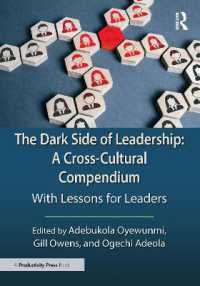Full Description
This book draws on contemporary occupational therapy theory and research to provide occupational therapy students and clinicians with a practical resource on implementing occupation centred practice with children. Each chapter has specific objectives and uses case studies to demonstrate the clinical realities and applications of each of the topics addressed. Best practice guidelines are provided along with a summary of recommendations drawn from the relevant theories, occupational therapy philosophy and existing research. The book aims specifically to be practice based.
Contents
Contributors. Foreward. Preface. Acknowledgements. 1 Introduction to Occupation-centred Practice with Children (Sylvia Rodger). Introduction. Re-affi rming occupation: the core of occupational therapy. External infl uences impacting occupational therapy practice. The evolution of occupational therapy practice with children. Changing views of child development and maturation. Emerging views about occupational development. Refocusing occupational therapy with children Conclusion. References. 2 Becoming more Occupation-centred When Working with Children (Sylvia Rodger). Introduction. Theoretical underpinnings of occupational therapy with children. Top-down and bottom-up approaches to occupational therapy practice with children. Characteristics of occupation-centred practice for children. Conclusion. References. 3 Child- and Family-centred Service Provision (Sylvia Rodger and Deb Keen). Introduction. Defi ning the client: who and how many? Client-centred practice 46Child-centred practice. Family-centred practice and service provision. Becoming a child- and/or family-centred practitioner. Developing family-centred services. The extended family and community. Conclusion. References. 4 Cultural Influences and Occupation-centred Practice with Children and Families (Alison Nelson and Michael Iwama). Introduction. Culture and the occupations of the child. The privilege of occupational therapy. Cultural safety in occupational therapy. The Kawa Model: a tool for culturally safe practice. Culturally appropriate goal setting. Making the invisible visible. Relationship: the art of occupational therapy. Conclusion. References. 5 Enabling Children's Spirituality in Occupational Therapy Practice (Imelda Burgman). Introduction. Spirituality and children. Why does spirituality matter in occupational therapy practice? The art of occupational therapy practice. Children's contexts and spirituality. Conclusion. References. 6 Occupational Goal Setting with Children and Families (Nancy Pollock, Cheryl Missiuna, and Sylvia Rodger). Introduction. Giving children a voice. Goal setting and motivation. Tools to facilitate goal setting with children. Goal setting contributes to outcome measurement. Conclusion. References. 7 Occupation-centred Assessment with Children (Ted Brown and Chi-Wen Chien). Introduction. Bottom-up and top-down approaches to assessment. OCAC. Implementation of occupation-centred assessment with children: assessment in action. Occupation-centred assessment with children: tools. Conclusion. References. 8 Cognitive Orientation for Daily Occupational Performance (CO-OP): A Uniquely Occupation-centred. Intervention created for Children (Sylvia Rodger and Helene Polatajko). Introduction. CO-OP: a brief overview. CO-OP: an occupation-centred intervention. Conclusion. References. 9 Perceive, Recall, Plan and Perform (PRPP): Occupation-centred Task Analysis and Intervention System (Christine Chapparo). Introduction. Information processing and occupational performance. The Perceive, Recall, Plan and Perceive (PRPP) System of Task Analysis and Intervention. Using the PRPP System of Task Analysis and Intervention: David. 'Perceive': observing and prompting sensory processing behaviours during task performance. 'Recall': observing strategies used for storage and retrieval of information during task performance. 'Plan': processing information for organisingand problem solving. 'Perform': processing output and performance feedback. Conclusion. References. 10 Occupational Performance Coaching: Enabling Parents' and Children's Occupational Performance (Fiona Graham and Sylvia Rodger). Introduction. Theoretical and philosophical basis. Three enabling domains. Structured problem-solving process. Conclusion. References. 11 Occupation-centred Intervention in the School Setting (Elizabeth A. Hinder and Jill Ashburner). Understanding the occupations of the school student. Educationally relevant occupational therapy in schools. Ways of working in schools. Planning educational programmes for diverse learners. Occupation-centred information gathering in educational settings. Occupation-centred programme planning and intervention in schools. Collaboration in service delivery. Conclusion. References. 12 Enablement of Children's Leisure Participation (Anne Poulsen and Jenny Ziviani). Introduction. Outcomes of healthy leisure engagement. EACH-Child: model of leisure coaching. Step one: creating successful engagements. Step two: coaching to promote personal growth. Conclusion. References. 13 Acute Hospitals: A Challenging Context for Occupation-centred Practice with Children (Sylvia Rodger and Rebecca Banks). Introduction. Occupation-centred practice in hospital settings: lessons from the literature. Occupation-centred practice in hospitals: lessons from the frontline. Challenges to occupation-centred practice in hospitals. Strategies to foster occupation-centred practice in children's hospitals. Examples of occupation-centred practice in children's hospital settings. Conclusion. Acknowledgements. References. 14 Enabling Children's Occupations and Participation using Assistive Technology (Desleigh de Jonge and Rachel McDonald). Introduction. What is assistive technology? What can assistive technology offer children and families? A theoretical model for understanding assistive technology. Information gathering for augmentative and assistive technologies. Utilising assistive technology for children as an occupation-centred intervention. Specifi c assistive technology interventions for children. Evaluating AT outcomes. Conclusion. References. 15 Decision Making for Occupation-centred Practice with Children (Jodie Copley, Sally Bennett, and Merrill Turpin). Introduction. Decision making and information sources. Information about clients, families and their contexts. Information about the practice context. Information from empirical research. Information from clinical experience. Integrating information despite alternatives and uncertainties. Shared decision making. Conclusion. References. Index.






